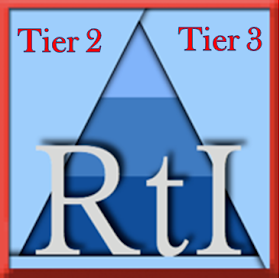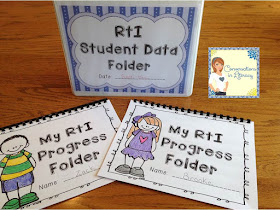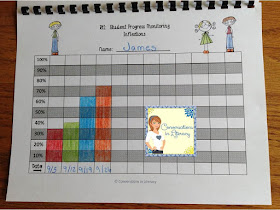Last Sunday I introduced to you how my school has implemented RtI. I explained Tier 1 and you can read it here if you missed that part. This week I am attempting to describe to you how Tiers 2 and 3 are conducted at my school.
We use Developmental Reading Assessment (DRA) for our universal screening. I also use phonemic awareness assessments with kindergarten for universal screenings. I have set up cut off points for each grade level for where students should score. If students do not score within these ranges, they are automatically placed into RtI. If they have never gone through the system, the first step is to be placed into tier 2.
Once students are placed into either tier 2 or tier 3, then I make decisions based on how they performed on the DRA or phonemic awareness assessments as to what interventions they need. I also group students according to interventions needed and/or reading level. For tier 2, we keep our groups to 6 students per teacher or less. But I must say that there have been several times that this has been an impossibility for us due to staffing. I just don't have enough staff members available always to keep the numbers as low as I would like for tier 2. For those students that have worked their way up to tier 3 due to lack of adequate progress in tier 2, we have groups of 2 or less per teacher.
Our school has a designated time each morning for RtI. We split the times for K-2 and 3-5. That does help with staffing. I have my tiers in increasing duration and intensity. For tier 2, we go for 10 weeks in small groups working on 2 interventions at a time. In tier 3, we intervene one on one or two for 12 weeks with 2 interventions but with more rigorous methods.
I do not use a program in RtI. I am not a program person. I know lots of schools use Aimsweb and other programs. Our principal bought us Acuity this past year, but I do not use it for tiers 2 or 3. I prefer to delve more into how the students performed on the DRA or phonemic awareness assessments to decide on what intervention best meets their needs. I will admit though at times, I think those programs might make my job of overseeing all of this and getting everything prepared for all of my teachers to use would make my life much easier. But I really think doing what we are doing is working so well and the proof is in the growth evidenced in our scores.
Once students are placed into groups, teachers who are doing the interventions give students 3 of the same assessments. This is to obtain their baseline scores for our graphs. Then those scores are averaged, graphed, and connected on the graph to their goal (might be a certain score or percentage).
Then each week students are instructed in interventions that are best for them. For instance, it might be rhyming and beginning sounds for kindergarten. Then every Friday, students are given an assessment to check on how they are progressing. If they are progressing the way we would like, the points plotted on the graph each week should be increasing. If not, the teacher may need to adjust their teaching methods or a different intervention may be needed (they might not be ready yet for that intervention).
The teachers teach interventions, weekly progress monitor (test), and graph the progress on the graph weekly. Then at the end of 10 weeks or 12 weeks, depending on which tier they are in, a decision meeting will be held to decide if the students made adequate progress or not and whether to change them in tiers or interventions. Next Sunday, I will be explaining how we run our decision meetings and how we come to our decisions regarding the students and the tiers they are in. How do our tiers 2 and 3 compare to yours? I would love to hear about how your tiers are run. This is definitely a work in progress for us and I am always looking to improve our process for the best interests of our students' learning!
We like to keep lots of RTI data on our students. These binders containing graphs for both teachers and students to track progress may help you with your RTI. Click here or on the pictures to check them out! I have binders for each grade, K through 3 with 4th grade coming by the end of July!






We use Guided Reading Plus and Comprehension Focus Groups as some of our models for our RtI groups in 3,4, and 5. We are also seeing great progress in some of our kiddos using these methods.
ReplyDeleteEach grade level has a 30 min period designated for RtI too, but we also have staffing problems, because our building has not reading specialists or reading coaches. We just have the classroom teachers and, usually, an LBS I or an aide.
What do with your kiddos who do not need intervention during this time?
We don't use a program for RtI either- we do have Aimsweb but I think it is just used to monitor fluency? Each grade level has at least 30 minutes for intervention/enrichment. We do have a Title 1 teacher and possibly a paraeducator that is available to assist the classroom teachers at that time. It is nice because then we can have multiple interventions going at the same time. We also share our students across the grade level so that I am leading one intervention group and one of the other teachers might take all the students and provide enrichment.
ReplyDeleteLooking forward to the next installment!
Julie
Light A Fire in Third
This is such a super helpful post {and posts} about RtI. Thanks for sharing. :)
ReplyDeleteErica
sprinklestokindergarten.blogspot.com
It must take so much work on your part to stay on top of all of this. It makes me brain hurt just thinking about it. Like you said, it would easier with a program (which is what our Title 1 has), but the individual attention that you're giving to interventions is obviously making a difference. One size fits all does not work. Your school is blessed to have you.
ReplyDelete❀ Tammy
Forever in First
Thanks for sharing. Love this information.
ReplyDeleteThis post was so interesting! We do RTI at my school, but we do it VERY differently. We have push in resource groups for our intensive kids during our a specified time. On top of academic RTI, we also have a lot of behavioral RTI at my school. This is not pretty. We have AIMSweb, and we use it for school wide testing 3x a year to progress monitor.
ReplyDeleteI'm your newest follower :) yay!
Katie
Dirty Hands and Lesson Plans
Jennifer, I like to use the Guided Reading Plus also (tier 3). Staffing seems to be a problem in many schools. :( Those not needing intervention stay with classroom teachers. They are to work on enrichment activities in the classroom or activities to help prepare them for our state testing. Thank you so much for commenting!
ReplyDeleteJulie, some of our teachers do what you described: one takes a group that may need a particular intervention while the other grade level teacher may take the rest of the students for enrichment activities (tier 1). Some of our teacher just run different groups within their room. But tiers 2 and 3 are taken out of the class. Thank you so much for coming by again!!
ReplyDeleteThank you, Erica, for those kind words! RtI is a big subject to try to cover. And really I am still only hitting the highlights! Thank you for coming to comment! I appreciate that!
ReplyDeleteTammy, your kind words mean a lot! It is a HUGE job grouping students into small groups, assigning teachers, deciding on interventions, finding appropriate assessments, and making all of the copies for the packets so the teachers can just start and not have to do the prep work. Takes hours! Thank you for always supporting me!
ReplyDeleteThank you so much, Miss Nelson! I hope the information was beneficial to you. Thanks so much for coming by to comment!
ReplyDeleteKatie, isn't interesting how all the schools have different ways of implementing RtI? We do not yet have behavior handled formally under RtI the way we have reading. That is still coming for us. And definitely needed. Sounds like maybe you all are still working on it too?? Thank you so much for coming by my blog! I am now following you too. :)
ReplyDeleteInteresting post and nice to see that so many schools are still working out the kinks of their RtI implementation. Is your school considering SPED Tier 4 in this model?
ReplyDeleteWhat is your school doing for math intervention?
AIMSweb isn't a program per se but it is an excellent progress monitoring tool. The advantage to using AIMsweb over a self created tool is that you will be able to see if the student is making progress toward grade level based on national norms. It also will give you the expected rate of improvement so you can see if a student is making adequate progress when you do a gap analysis. Additionally it is really helpful for your SPED teachers when they have to determine gap!
Just my two cents :)
Rachel, thank you for commenting and I appreciate your two cents! :) To answer your question, if students do not make adequate progress and have gone through 2 tiers then we refer to special ed. We have been unable to implement this for math yet, again staffing is a problem and time. That is to be coming though and hopefully soon as we need it badly. I do use the national norms and rate of improvement. I have been taught the formula for this and I figure them myself and plot on our graphs. I do believe that to be very important to be able to tell if students are progressing at the rate we need them to or if we need to change how we are teaching the intervention or to change the intervention itself. We are a small school with 2 to 3 classes per grade level and by not using Aimsweb or other computer programs and doing it myself, I feel I have a better handle on what the students are doing and how they are learning (maybe it is a control issue!! lol!) If we were a larger school, there is no way I would be able to do it all. Thank you again for commenting, I do really appreciate it!!
ReplyDeleteI'm loving these posts. I think RTI is done MUCH differently at my school. I'm a resource teacher so we're not involved with the RTI Process at all. We only see students once they're staffed ESE. I'd love to hear some of the interventions you use. Our school isn't a Title 1 school, so it seems like we miss out on a lot of resources other schools are able to use.
ReplyDeleteAngelia
Extra Special Teaching
Amanda, thank you for coming by my blog. I am now following your cute blog!!
ReplyDeleteAngelia, I have found RtI is being done in a lot of different ways. To your question about what interventions we use: It depends on what the students need and where they are with their reading skills. We use a lot of phonemic awareness and phonics in K and beginning first (letter id, letter sounds, beginning or ending sounds of words, phonemes, rhymes, syllables, etc...), sight words, fluency, root words and affixes, multi-syllabic words, comprehension, etc... Too many to list them all, but hope that helps!
ReplyDeleteLori, what you do is wonderful! Our RTI program is very similar to yours, but we have Aims Web and STAR To do our whole school benchmarking 3X's/year and to progress monitor weekly. I just wish our group sizes were as small as yours. Keep up the great work and thanks for sharing!
ReplyDeleteAmy
Amy, thank you so much! We try very hard to keep our groups small, but there have been times that our numbers are bigger that what we would like. Thanks for commenting!
ReplyDeleteLori,
ReplyDeleteWe are just implementing RTI with 30 minute sessions first thing in the morning. Since I am the math, science and SS teacher and love my morning routine of getting right into the lesson, this is really cramping my style. Have you been doing this for awhile that you feel all the extra work is making a difference? Part of our students will be leaving the classroom so I will have to prepare additional enrichment activities. I am a dedicated teacher so I will do this for my students, but I just don't feel confident in the process. We move at such a rapid rate, that it is already a challenge for students to learn all the concepts that I must cover before FCAT testing.
Dianna, I understand about the 30 minutes cutting into your class time and routine. That 30 minutes is hard to give up! We have been doing this for several years now and I absolutely feel the extra work is making a difference! But I have to disclose that we have only implemented reading so far and we are an elementary school. By your post I am wondering if you teach middle school? Middle school RtI works completely different than in the elementary. At my school, I have RtI running in a very systematic and organized way, which I feel helps it to succeed. I do understand your concerns about how much you have to cover in class now as it is. Do you have someone in charge of RtI at your school? Maybe you can voice your concerns to them and find a way to make it work better for you. Thank you for your comments! Good luck to you and your school!!
ReplyDeleteIn your last reply, you said RTI in middle school works completely differently than in elementary. Can you give some examples as to how it differs? I teach 5th grade (middle school in my town) and I'm unsure I am doing everything I should be.
ReplyDeleteHi Sarah! For our middle school/junior high school, RTI would be a different set up due to the classes all being specialized to specific subjects. Mike Mattos has a book out on RTI and it is super helpful for setting up and running RTI, especially middle schools. Hope that helps you!
DeleteThis comment has been removed by the author.
ReplyDeleteThis comment has been removed by the author.
ReplyDelete